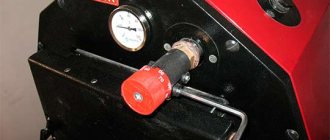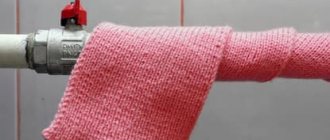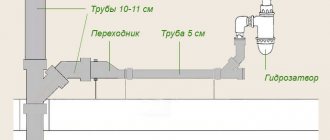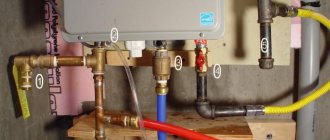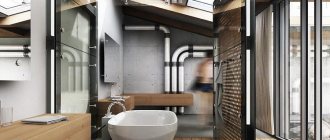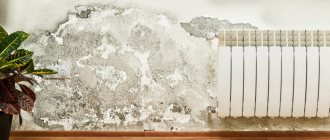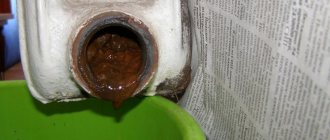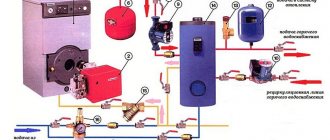Incorrect connection
Incorrect piping is one of the possible reasons for a decrease in the efficiency of the radiator. This is a gross mistake, experienced craftsmen do not allow such oversights, most often they occur after the work is done by amateurs.
Incorrect installation of the radiator
The pipe, which is intended for the return, is connected to the upper branch pipe, the supply to the lower one. As a result, a spectrum of related problems arises:
- The circulation of water and the full operation of the heating system are completely disrupted.
- The efficiency of the radiator and its heat transfer decrease, and water is unable to completely fill all sections.
- The process of draining liquid from the battery is disrupted.
Water enters through the bottom pipe, flows in a circle and leaves the radiator. Its sections do not warm up, the real efficiency is significantly reduced. The upper connection does not allow liquid to be drained from the inside, because the design features of the radiator do not allow creating increased pressure for its output through the upper pipe.
Incorrect and correct connection
Getting inside, hot water tries to immediately rise up, because it has a lower density than cold water. The coolant travels the shortest path, and the liquid does not move in the sections.
When properly connected, water enters from the top and flows through the upper manifold. The radiator has a lower pressure, the liquid flows into the columns and is directed to the lower part. With this scheme, the battery is fully heated.
How to fix the wrong connection:
- Completely disconnect the pipes from the connections.
- Implement a fundamentally different scheme, taking into account that the supply is carried out through the upper pipe, and it must be connected from the top, and the return flow - from the bottom.
- Connect the elements to the battery, open the supply and check the operation of the radiator.
The reasons
One of the reasons for insufficient heating of the battery is pipe corrosion.
In fact, a sewer riser is a finicky thing. Therefore, there may be several reasons why the water supply risers turn out to be hot, although the radiator itself is cold. Let's consider the most common ones.
- The water supply valves are out of order, or simply blocked in the basement. Through this valve, water flows through the highway to the apartments. Therefore, since it is blocked there, it means that the heat does not go.
- There is an option in which the pipe was damaged in the process of welding the riser to the line.
- It also happens that when installing the riser of the heating system in the pipe, the master left some foreign object. Rags, mittens, sometimes even stones and animals were often pulled out from there.
- Option with incorrect installation of heating pipes in other rooms, in the kitchen, due to which water does not enter the battery, but passes by.
- A small amount of heat carrier, that is, water, can pass through the risers of the water supply. This situation can apply to both the whole house, or a separate entrance.
- It is possible that the water supply risers, like the entire heating system, were simply incorrectly adjusted, adjusted, due to which the required amount of water does not flow to the heating radiators in the apartment building.
Errors in the installation of a water heated floor. Myths.
The most widespread myth is that it is impossible to heat a building with warm floors only - it is imperative to install radiators. Because underfloor heating is not able to warm up the building.
Error number 1.
In my opinion, the worst mistake in the installation of any heating system is the lack of calculation of the heat losses of the building.When heat losses are not counted, then we can say the heating system is done by eye.
Radiators are selected by eye, usually they are selected according to the size of the window or at the rate of 1 section per 10 square meters, if sectional radiators are used. Heated floors are made by eye. Or they mold radiators in rooms with warm floors "just in case."
If you communicate with such an installer, chase him in the neck. As a result, you will either get a non-working system, or spend extra money on the construction of a heating system. Because the installer insured himself for your money and stuffed unnecessary heating appliances.
Or vice versa - installed low-power heating devices. In any case, these are losses.
Other reasons
A common cause is a reduced flow rate of the coolant. This problem can occur in several cases:
- Narrowed pipe section.
- The heat carrier moves at low speed directly in the heating system.
A low speed of movement of the coolant occurs when there is insufficient pump power to circulate the liquid inside the system. Water cannot overcome the radiator with sufficient speed and go into the drain. A similar problem often arises in gravitational systems, they completely lack additional equipment.
The simplest gravitational scheme
Narrowing of pipes occurs in several cases:
- Incorrect brazing of PP pipes.
- Problems arise when installing a narrow section control valve.
- The presence of deposits in the pipe, reducing the throughput.
Control valve
Another possible reason is a rather low room temperature. Cooling of the coolant in the radiator is faster, it gives up the maximum amount of energy. It is only natural that the bottom of the battery can be much colder.
Signs and causes of poor heating performance
| Characteristic signs | Possible reasons |
| Riser cold | Technical malfunctions outside the apartment |
| The riser is hot, the batteries are cold | Closed valves, clogging of the heating system |
| Cold bottom of the radiator | Insufficiently open valves, clogged radiators, low pressure of the coolant in the pipes |
| Cold top of batteries | Airlock |
| The last radiator in the system is cold | System not adjusted, insufficient pressure |
| The part of the radiator farthest from the connection pipes is cold | Insufficient pressure, battery clogged, airlock |
An analysis of the events preceding their occurrence will help to identify the causes of malfunctions.
| Work carried out, features of operation | Possible malfunctions |
| Replacement of heating devices, pipes | Air lock due to air entering the system or changing pipe slopes. Clogged pipes and radiators. Reduced flow areas due to assembly errors |
| The heating system works without maintenance for many years | Scale has formed, the heat transfer of the batteries has worsened, the parts of the shut-off valves have become stuck |
| The beginning of the heating season | The boiler room did not reach its design capacity, the employees of the relevant services forgot to open the valves, and air locks formed when filling the system. |
| Neighbors were doing repairs | Reducing pressure in the system due to unprofessional actions of neighbors |
First of all, in case of poor heating, interview the residents of the house. If they have the same problem, it means that the boiler room is not working well or the valves in the basement of the house are closed. In these cases, you should jointly contact the management company. If only one apartment is cold, check if the valves are open and there are no air locks. Call a technician through your home service provider.
Riser blockage
Sediment forms on the inner walls of the heating pipes. Gradually, its thickness grows.If the diameter of the riser pipe is larger than that going to the radiator, then the batteries will be cold. Sediment of small thickness significantly reduces the cross-section and throughput.
You can only visually check the pipes for clogging. To do this, you must turn off the heating throughout the riser and drain the water in the basement. Thereafter remove the radiator together with the taps and inspect the inside of the pipes.
The best option is to clean the pipes going from the riser to the radiators. If they are long, it will be difficult to do this. We'll have to use special pipe cleaning products. Their effectiveness depends on the type of deposits.
If it is not possible to turn off the riser or clean it, you can cover the bypass. So you reduce the throughput of the riser, water or heat carrier under high pressure will go into the heater. But this is a temporary measure.
Important
If the bypass is closed, the pressure in the system will increase. The risk of leaks at the joints of valves, pipes and radiator will increase.
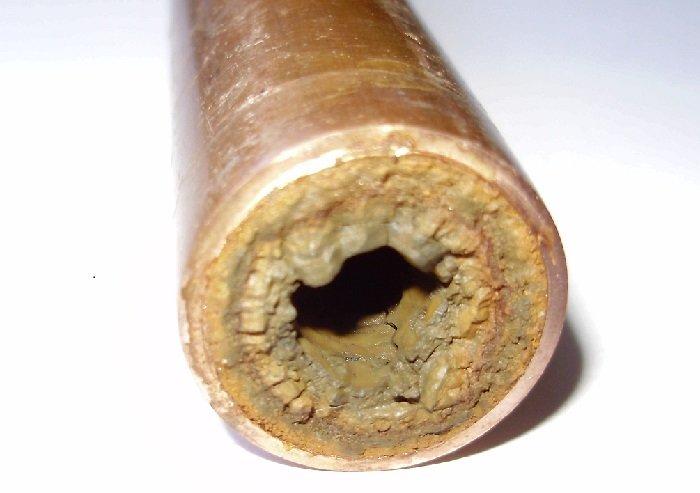
Sediment on the walls of the heating pipe.
How to make radiators hot - looking for solutions
If it is found that the return is too cold, a series of troubleshooting steps should be taken. First of all, you need to check the correctness of the connection. If the connection is not correct, the down pipe will be hot, but should be slightly warm. Connect the pipes according to the diagram.
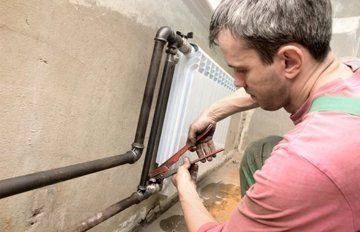

So that there are no air locks that impede the advancement of the coolant, it is necessary to provide for the installation of a Mayevsky valve or a vent for air removal. Before bleeding air, shut off the supply, open the tap and release the air. Then the tap is closed and the heating valves are opened.
Often the cause of the cold return is the control valve: the section is narrowed. In this case, the crane must be dismantled and the cross-section must be increased using a special tool. But it is better to buy a new tap and replace it.
The reason may be a clogged pipe. It is necessary to check them for permeability, remove dirt, deposits, and clean well. If the passability could not be restored, the clogged areas should be replaced with new ones.
If the speed of movement of the coolant is insufficient, it is necessary to check whether there is a circulation pump and it meets the power requirements. If it is absent, it is advisable to install it, and if there is a lack of power, replace or modernize.
Knowing the reasons why the heating may work ineffectively, you can independently identify and eliminate malfunctions. Comfort in the house during the cold season depends on the quality of heating. If you carry out the installation and inspection of the heating system yourself, you can save on hiring outside labor.
Quite often, in apartment buildings during the heating season, you can face the following problem: the riser is hot, and the batteries are cold. This applies to both new buildings and old houses. In most cases, residents do not know how to cope with such a situation. That is why their attempts to repair the heating system on their own do not lead to the desired result. In this matter, you definitely need help or expert advice. After all, only a person with the necessary knowledge and experience can solve the problem of why the pipes are hot and the batteries are cold.
How to eliminate air locks in radiators
Airlock is the most common cause of cold radiators. The appearance of air is a natural process caused by water heating, abrupt filling of the system, violation of tightness. It is not difficult to remedy this problem if the system is equipped with bleed valves. On modern radiators, they are located in the upper part of the products and work without interference, periodically bleeding air from the batteries.If automation is not provided, then the valve is opened manually and air is released until water appears.
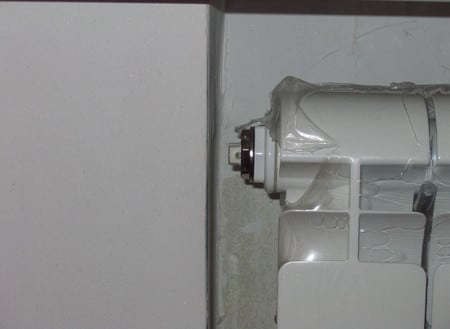

Modern heating devices are equipped with special valves
In heating devices of the old type, such taps are absent. In this case, you will have to work a little and remove the plug. Before you start unscrewing, be sure to put the basin on the floor. In no case should the lid be completely unscrewed, it is only slightly unscrewed until a barely audible hiss appears. At this moment, the key must be put aside and wait until all excess air is released from the system and water begins to ooze. After that, the plug must be carefully screwed on. Just in case, you can leave the basin for a while to make sure no water drips.
It is not allowed to completely unscrew the plug! This can cause flooding of the apartment!
Causes of problems with the return in the batteries of a private or apartment building
There are several reasons why the return line is not warm enough or completely cold. Common problems are:
- insufficient water pressure in the system;
- small section of the pipe through which the coolant passes;
- improper installation;
- airiness or contamination of the system.
If a problem with a cold return flow has arisen in an apartment, then the first thing you should pay attention to is the pressure. This is especially true for rooms on the upper floors.
The fact is that the principle of operation of the return flow is to quickly and continuously run the fluid through the system. And if its speed drops, then the coolant will not have time to push out cold water and the batteries will not heat up.
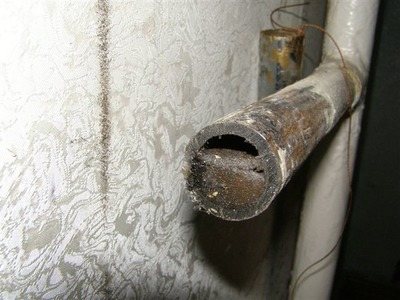

Another reason for the malfunction of the return is contamination of the heating circuit. As a rule, major cleaning of systems in multi-storey buildings is not often carried out. Sediment that builds up over time on the pipe walls impedes the passage of the liquid.
The main reason for interruptions in the operation of the heating system in a private house is improper installation. Most often this happens when the installation is carried out without the participation of specialists. Being incompetent in this matter, it is quite easy to confuse the supply and return pipes or choose the pipes of the wrong size.
Both in an apartment and in a private house, the problem of a malfunctioning heating system may be associated with an insufficient water supply rate or airiness. In a similar way, the contamination of the pipes affects the operation of the return.
Troubleshooting methods. Why is cleaning necessary?
To understand how exactly to solve the problem, you first need to establish its source. If the batteries become cold due to insufficient rapid circulation of water, the installation of a special pump will help in this case. It will regularly push water into the circuit under a certain pressure, thereby preventing the system from stopping or slowing down.
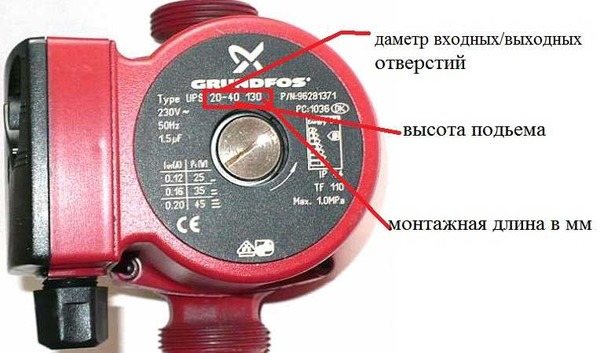

Photo 2. Marking of the Grundfos circulation pump allows you to choose the most suitable one and install it correctly.
If the reason is the clogged pipes, then they just need to be cleaned. This can be done in several ways:
- using a water-pulsating mixture;
- with the help of biological products;
- by means of a pneumohydraulic impact.
Important! Such cleaning is carried out regularly in order to prevent the emergence of new problems. In the event of a malfunction due to improper installation of the equipment, contact the wizard
A qualified specialist will certainly understand the problem and fix all the problems. In addition, he will give practical advice and recommendations for the maintenance and operation of the system.
In the event of a malfunction due to improper installation of the equipment, contact the wizard. A qualified specialist will certainly figure out the problem and fix all the problems. In addition, he will give practical advice and recommendations on the care and operation of the system.
The nuances of heating and what to do if half of the heating battery is cold
The question why there is a cold battery in the bathroom and why the apartment is cold and the batteries are cold, especially on the upper floors of apartment buildings, can be answered by understanding how the heating system works. Initially, it is designed taking into account the length and diameter of the pipes, the number of sections that make up the battery, in order to thus ensure uniform heating of the entire house. When residents begin to interfere with the arrangement of the system, re-equipping the location of the batteries, adding the number of sections, they thereby disrupt the usual scheme and heat exchange. For example, the battery on the ground floor, which consists of four sections, receives water at a temperature of 90 degrees. After passing through the battery and heating it, the water goes to the second floor, to another apartment. Its temperature is already 85 degrees, and in order to create a comfortable climate in the apartment, the batteries here should already be 5-section. Further, higher on the floor, 6 sections will already be required. And thus, with each floor, the water cools more and more, which is why cold water flows from the battery, and the number of sections should increase. The diameter of the pipes is also important, which is necessary for the excellent operation of the batteries. This, of course, is not the whole process taking place in the heating system, but approximately, it gives an idea of its functioning. A breakdown in the system leads to the problem of why the risers are hot and the batteries are cold and why the pipes are hot and the batteries are cold.
And so, the owner of one of the apartments found out on himself what a too cold battery meant, began to freeze and added the number of sections to the radiator, or installed another battery to better heat his living space. Of course, in his apartment it will become noticeably warmer, but the water, cooling in this apartment faster, on the next floors will no longer be able to warm it to a comfortable temperature. And the further, the worse, and the system becomes unusable, due to the fact that residents of other apartments, trying to heat their homes, begin to independently increase the number and power of their batteries, which is why there may be cold batteries on the 1st floor.
The consequences of a cold return
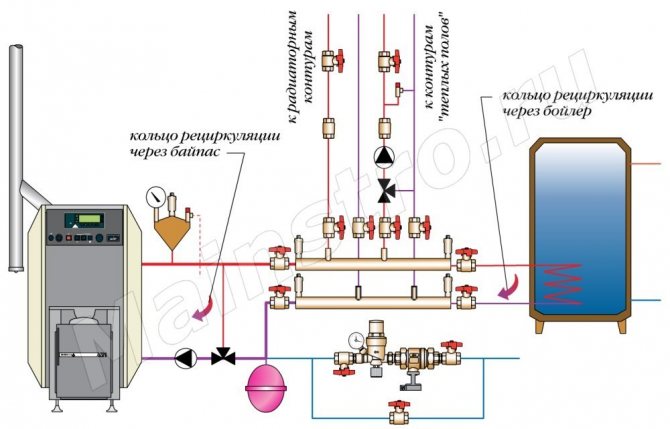

Return heating circuit
Sometimes, with an incorrectly designed project, the return flow in the heating system is cold. As practice shows, the fact that the room does not receive enough heat during a cold return is still half of the trouble. The fact is that at different supply and return temperatures, condensate can fall out on the walls of the boiler, which, when interacting with carbon dioxide released during fuel combustion, forms acid. She then can disable the boiler much ahead of time.
To avoid this, it is necessary to very carefully consider the design of the heating system; special attention must be paid to such a nuance as the return temperature. Or include additional devices in the system, for example, a circulation pump or a boiler, which will compensate for the loss of warm water
Radiator connection options
Now we can say with more than confidence that when designing a heating system, the supply and return must be ideally thought out and configured. With the wrong design you can lose more than 50% of the heat
.
There are three options for inserting a radiator into the heating system:
- Diagonal.
- Side.
- Lower.
The diagonal system gives the highest efficiency factor and is therefore more practical and efficient.
The diagram shows a diagonal inset
How to regulate the temperature in the heating system?
In order to regulate the temperature of the radiator and reduce the difference between flow and return temperatures, you can use the temperature controller of the heating system.
When installing this device, do not forget about the jumper, which must be located in front of the heater. In the absence of it, you will regulate the temperature of the batteries not only in your room, but also throughout the riser. It is unlikely that the neighbors will be delighted with such actions.
The simplest and cheapest version of the regulator is the installation of three valves: on the supply, on the return and on the jumper. If you close the valves on the radiator, the jumper must be open.
There is a huge abundance of different thermostats that can be used in apartment buildings and private homes. Among the wide variety, each consumer can choose a regulator for himself, which will suit him in terms of physical parameters and, of course, cost.
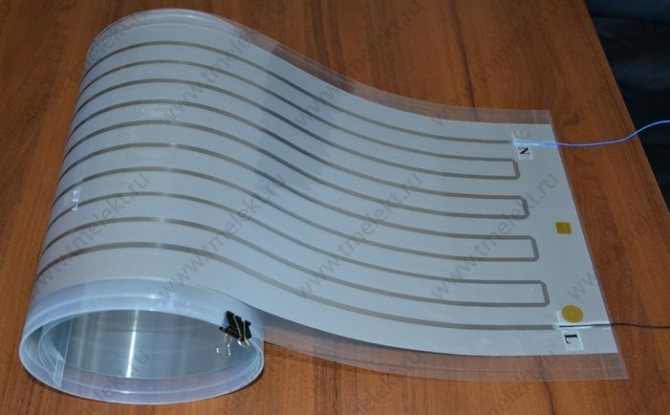

Infrared film heating - pros and cons
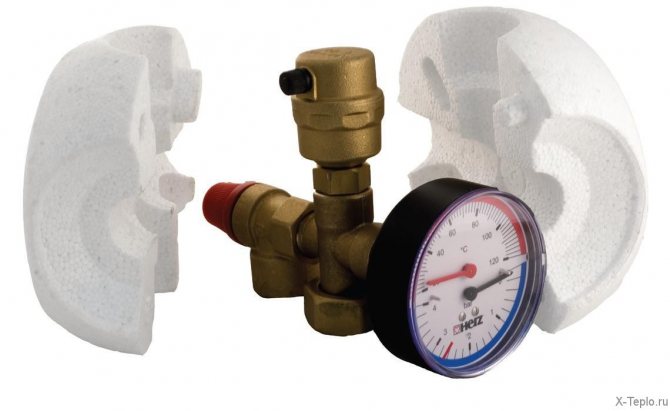

Safety valve in the heating system
Heating system
What could be the reasons for cooling heating devices in an autonomous system?
Completely cold appliance
In a two-pipe system with a sufficient length of the circuit, a situation is possible when the first heating devices from the boiler or circulation pump will be hot, and the latter will cool down shortly after starting.
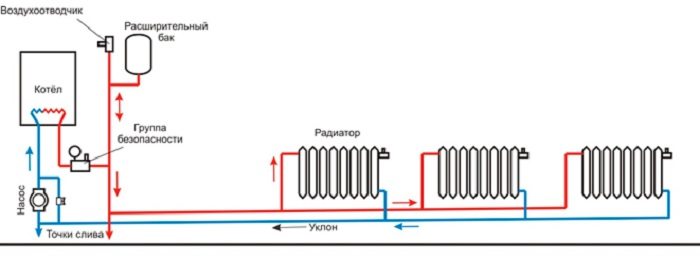

The simplest two-pipe system.
Why are the last radiators cold in a two-pipe system and what can be done about it?
Let's imagine the fluid dynamics of a circuit. A certain pressure difference is created between the supply and return filling.
With distance from the boiler or pump, this difference decreases due to the action of two factors:
- The hydraulic resistance of the pipe. It is determined by its diameter and wall roughness.
- The number of jumpers between dispenses. In this case, the batteries themselves act as jumpers; with the same passability of the connections, the main volume of the coolant will inevitably circulate through the nearby radiators. The author knows cases when severe frosts led to defrosting of two-pipe heating systems.
The solutions are pretty obvious:
- A pipe with an internal diameter of at least 25 mm is used as a filling. Ideally, polymer or metal-polymer: its smooth inner surface provides minimal resistance to flow.
- All heating devices are throttled; the passability of the supply lines of the batteries closest to the heat source is artificially limited by the chokes up to the equalization of the temperatures of the first and end radiators.
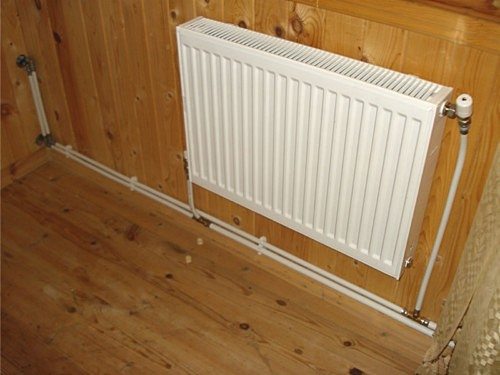

The choke on the liner, clearly visible in the photo, limits its permeability.
Partially cold appliance
Why is the radiator hot from above and cold from below in an autonomous system? Why are the end sections of long radiators noticeably colder than the first ones? After all, it would seem that in a closed autonomous system, silt and dirt have nowhere to come from.
The reason is in the same hydrodynamics. With sufficient passability of the channels, the coolant will always move along the shortest line between the supply and return connections.
How does it look in practical terms?
- With a large number of sections and side piping, water will flow through the first sections; in the latter it will stagnate.
With lateral connection, the coolant moves along the shortest path between the radiator manifolds.
- The bottom of the radiator is cold and the top is hot when connecting the connections to the upper pair of plugs. Most often, this mistake is made when laying the filling in the attic.
The solutions are obvious - for long batteries, a diagonal connection is used, in which the sections will be evenly heated along the entire length.
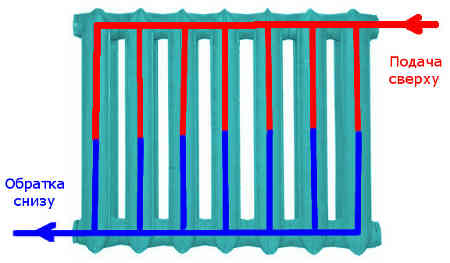

The movement of the coolant with a diagonal connection.
What to do if the batteries in the apartment are cold and the riser is hot
Regardless of whether the cold heating equipment is only along the riser or in the entire entrance, and possibly completely around the house, it is necessary to seek help from qualified specialists.In the case of an apartment building, this is the plumber of the company that is responsible for the heating of the house.
Cold batteries with a hot riser can be due to a blockage in the system or the formation of an air lock in it. The pressure in the wiring is also an important factor. In some cases, the problem of a low flow rate of the coolant is actual. It is possible to independently find out the reason for the low efficiency of the heating elements. But only a real professional in his field will unequivocally answer the questions that have arisen and correctly eliminate the breakdown. How to make heating radiators warm better video will help:
This article lists the main malfunctions that can happen with the heating system of a private house, and also provides ways to eliminate them. Troubleshooting the heating system can be divided into two types. DIY heating system repair
can be produced in terms of the wiring of the heating system: radiators and fittings. All malfunctions that arise in part of the boiler room and equipment require special knowledge and experience, therefore
repair of the heating system
associated with the equipment, it is better to entrust specialists.
The questions that the owner of the house can solve himself are given below.
Methods for flushing radiators and new methods for cleaning the internal surface
During operation, the inner surface of the heating system becomes covered with rust, salt deposits, and other impurities. All this complicates the circulation of hot water and significantly reduces the air temperature in the apartment. Regular cleaning of the radiators removes blockages and restores normal circulation of the heat carrier.
It is allowed to clean the heat exchanger equipped with outlet and inlet taps even during the period when the central heating is already working, but when the riser is hot, the batteries remain cold. First of all, both taps are closed, then the radiator is removed with a suitable wrench and divided into sections. The next part of the work does not require special skills - each element is washed well under a strong stream of water. If a lot of scale has accumulated inside and the sediment is not simply removed, you will have to deal with it with the help of chemicals. After drying, the entire structure is assembled in its original form, and all joints are carefully sealed.
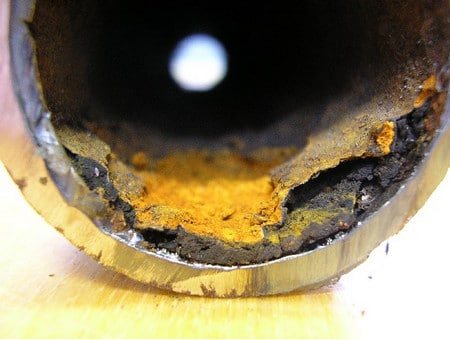

Such plaque does not allow the heating system to work normally.
Heavy batteries that cannot be removed are rinsed in place. To do this, remove one plug, and then pour inside, preferably under pressure, hot water, to which a chemical solvent, for example, soda ash, has been added. In this state, the heating element is left for a couple of hours, then the solution is drained and clean water is poured under pressure. It is advisable to make several rinses, and if necessary, you can repeat the chemical treatment. To enhance the effect on the compartments, you can slightly knock before the water is poured, this will help the bloom move away from the walls.
Ideally, flushing should be done before the start of the heating season, when the utilities have not yet poured water into the system, but have already blown through the risers.
For heat exchangers that are problematic to turn off and flush, there is professional equipment that allows you to point-wise remove deposits in any season, including heating. The result is achieved through high pressure, compressed air and shock waves. Such equipment allows you to clean not only radiators, but also pipes.
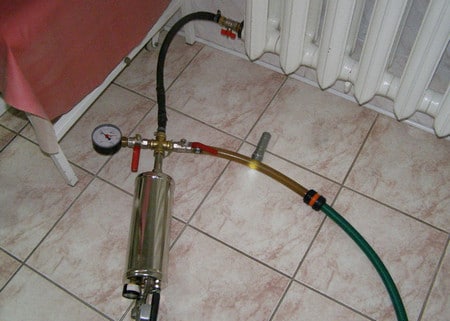

A powerful device can be used to clean the system at any time of the year
Reason 1. Lack of thermal insulation
The most common reason why a warm floor does not cope with the functions assigned to it is that you simply forgot to install the thermal insulation properly, or did not install it at all.Often, a conventional polyethylene foam backing is used as thermal insulation. And the substrate is simply not intended for thermal insulation of warm floors. Instead, you need to use polystyrene foam with a thickness of 5-10 cm.
How to fix it?
Consider one thing. You will have to overpay for a warm floor. But it is possible that the situation will be corrected by a higher temperature supply to the warm floor and the use of more powerful heating equipment. But don't overdo it. The maximum temperature should not exceed 70 degrees. And it shouldn't be permanent. Otherwise, the pipe will quickly become unusable.
The battery does not heat up
If one or more radiators does not heat or does not heat well, then the first step is to check if there is air in them using air vents. If water comes out of the drains, but the radiator still does not heat, then you need to make sure that both taps of this radiator are open (such inattention can often take place). The next step is to check if the radiator is clogged. To do this, other heating radiators that heat and are on the same branch with the non-working one must be shut off so that all the water goes through this radiator. If he began to warm up, then he is not clogged. In this case, it is necessary to carry out hydraulic leveling of the branch. In simple terms, it is necessary to cover the rest of the radiators on the branch so that the non-working one gets more. You need to be prepared that the alignment will take more than one day, because the heating system can react slowly to changes in settings. If the taps in front of the radiator are completely open, and it is cold, then it is clogged (extremely low probability). Basically, the last radiators on the branch may not heat up. But this can always be eliminated by hydraulic equalization. If someone tells you that "it does not pump there" or "insufficient pump power", do not rush to believe and touch the pump or pipes. In order for the pump not to “pump out” it is necessary to “try hard” when installing the heating system. If one or more of the last radiators do not heat up even after working with the taps, then there may be an air lock in the pipes (see circulation failure in the heating system).
This is interesting: Why does the pressure drop in the heating system, in the gas boiler - the reasons, which should be?
What problems arise in the apartment due to the cold return
Violation of the return flow leads to certain problems and troubles.
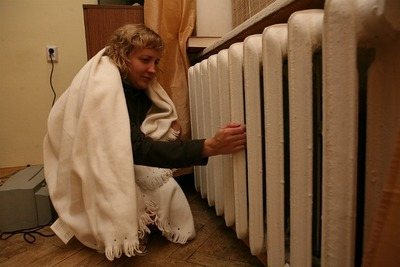

Firstly, the batteries in this case do not heat up properly, or even do not work at all. Accordingly, it becomes cold in the room itself, which is certainly not encouraging.
Secondly, in case of violations of the functionality of the return, a strong dissonance of the temperatures of the supply and discharge of the liquid arises.
This entails the accumulation of condensate on the walls of the boiler, which begins to react with carbon dioxide released from the combustion of fuel. The consequence of this process is the formation of acid, which corrodes the walls of the boiler, thereby destroying it.
Alas, the weather in the house does not depend only on our mood. The creation of the necessary, comfortable microclimate is provided by heating radiators, that is, batteries. Inside them, a stream of hot water passes, which heats the device, thereby ensuring the flow of heat in the rooms. Unfortunately, the apartment owners do not check the sewer riser as often as they should. In a panic that the heating riser is hot, and the batteries themselves are completely cold, we begin to take certain actions. Often they do not give any result.
So, first you need to stop panic, and seriously tackle the problem. The heating season has begun, you will have to pay for the heat, even if it did not reach your apartment for one reason or another. In order not to pay for cold batteries, you need to check the water supply risers, check how the sewer is functioning, make sure that heating has really started in your apartment building, and only you have some problems with this.
Actually, the primary task is to understand the reasons. It is they who will make it possible to understand why the water supply risers are hot, and the battery itself is cold. Already from here it will be possible to move on, in the direction of solving the problem that has arisen.Some situations even provide for a scenario in which you have to change the radiators. But, hopefully, it will not come to this, and the issue can be solved by simpler and less drastic methods.
- 1 Reasons
- 2 Fixing problems
2.1 Causes and their elimination
- 2.1.1 Trapped air
- 2.1.2 Replacing radiators
Radiators and how to avoid the situation when the cold return in the heating of the apartment
For an autonomous heating system, it is necessary to choose the right batteries. For example, one section of a radiator heats 1 square meter of area. And from what is the area of the room, you can calculate how many sections should be in the radiator. For even heat, you need to consider the nuances. In a corner room or balcony, you need to add a couple of sections to the radiator. It should also be borne in mind that various decorative panels that cover radiators reduce heat transfer, the installation of multi-profile windows, retain heat. Also, insulated walls and floors will keep the apartment warm. The installation of autonomous heating is a serious process that requires experience and knowledge. There are cases when individual heating is installed in one room with cold batteries, while in others the heat is constant or the entrance to the battery is hot, and the exit is cold. This is because mistakes were made during the installation. Independent work is best done at the final moment, when all pipes and batteries are supplied. But the installation of the boiler, equipment, risers and gas supply, it is better to entrust specialists, then there is no question why the floor of the battery is hot and the floor is cold. Once the system is installed, it is usually tested by filling it with hot water. Sometimes there are water leaks, mainly at the joints. The leak must be repaired and the pipes must be re-soldered. It is from improperly welded pipes that hot water can poorly enter the radiators, and after the water is drained in the apartment, the batteries remain cold.
Why the batteries are cold, perhaps for various reasons, and the heating of the premises can be carried out by old-fashioned methods, which, by the way, work well in the modern world. If the battery is half cold, what should I do? For example, using a conventional fan, you can disperse the heat from the battery throughout the apartment. You just need to install it near the radiator, aiming the blades at it, and turn it on. Behind the radiator against the wall, there is always a space where you can stick reflective foil or foam foil. The distance between the battery and the reflector must be at least two centimeters for air to circulate. Otherwise, it will have the opposite effect. But with all these methods, the best will be the respect for the heating system installed in the apartments. These methods can be used if cold air comes from the batteries in the Khrushchev. And if there is a leak in the battery, then it can be sealed with cold welding. This system has already been worked out, installed, and the correct use of the heating system, regular flushing of pipes and radiators, insulation of windows and floors, will help to achieve the long-awaited warmth in the apartment. And the installation of individual heating will create additional comfort.
The main thing is the weather in the house! The warm microclimate ensures the health and good nature of the household. So that they do not deteriorate, it is very important that the radiators in the house heat up perfectly. That is why, as soon as small frosts come, we look forward to the heating season. But it often happens that the house is neglected, but there was no heat and there was no heat. Why cold batteries? Why does the battery run cold water? Who is to blame and what to do? Most importantly, don't panic. Before you complain to the management company, you can find a sample complaint to the Criminal Code for cold batteries on our website, try to figure out the reasons, perhaps you can eliminate them yourself.
Why the batteries are cold, but the riser is hot, experts explain
Do not warm your hands on cold batteries.
There can be a lot of reasons why the supply pipe is hot and the radiator is cold. Specialists for general development name only the main ones:
- the central tap on the heat supplying line is closed or the return line is closed;
- insufficient coolant flow;
- airing the system or a specific riser, radiator;
- the heating system is not balanced;
- pollution in the heating circuit;
- reducing the cross-section of the pipe supplying the coolant.
However, the following actions of the residents of the house will help the craftsmen who have come to the call to quickly eliminate the malfunction of the heating circuit:
- it is necessary to install the pipe hot, and the radiator is cold only in one apartment, or this problem affects the entire riser. Perhaps the heating wiring of the entire entrance is faulty;
- it does not bother to go around all the entrances and see if the heating elements are hot there;
- you can go down to the basement and examine the pipes for breakdown. Even drip leads to a fall. This adversely affects her work.
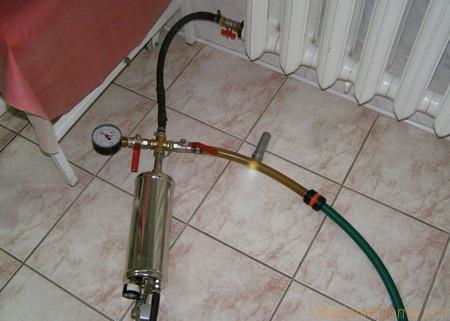

Contour cleaner.
If the batteries do not heat up the riser
... If the riser is cold, the battery is cold - this is a sure sign that the main line through which the coolant flows is blocked. In confirmation of this, it is necessary to walk through the neighboring apartments. They should warm up well. In this case, only a plumber can fix the breakdown, who will have on his hands the drawings for the wiring of the heating of the house.
The next state of affairs, when the pipe is hot and the battery is cold, indicates a blockage in the system or the presence of an air lock. They prevent the penetration of the coolant into the heating element. From this, the latter does not warm up. Clogs are removed only if the radiator is completely disassembled and air is blown through it under pressure. This can only be done by a specialist who has the necessary tools and equipment.
If the radiators do not heat up all over the entrance
... When the radiator is cold and the riser is hot, attention must be paid to the pressure in the circuit. With insufficient pressure, the coolant cannot pass through all the radiators in the circuit
As a result, the batteries lower their temperature as they move away from the heat-carrying line. Residents of the house cannot independently increase the pressure in the system, and therefore it is recommended to seek professional help. More specifically, call the organization that is responsible for the heat supply of the building.
Supply and return can be mixed up.
Residents of a new house, when starting the heating system for the first time, can observe the following situation when the battery is cold and the return is hot. Here it is appropriate to assume that mistakes were made during the installation of the heating elements. In this case, the pipes supplying the coolant and the return flow of the circuit are reversed. If we are talking about an individual heating circuit, then it is worth taking a closer look at the circulation pump. It may have been installed incorrectly.
When asked why there is a cold return in the batteries, experts unequivocally point to an incorrectly designed heating system. In some cases, it is appropriate to talk about a small flow rate of the coolant.
How to flush cold batteries?
At work and at home, scale, rust constantly forms in pipes and batteries, metal corrodes, and dirt appears in the system. And it is known that even a thin layer of scale already retains heat, as if the pipes are insulated with mineral wool. All these deposits reduce the functionality of the pipes, and hot water does not pass well to the radiators, which can lead to the fact that there will be a cold bottom of the radiator in the apartment, it will be especially cold in a corner apartment. It also leads to the formation of breaks in the pipes and spoils the heating system as a whole. And also, this is one of the reasons why the batteries are cold, while those of the neighbors are hot. They just have either new or well-washed batteries.To organize the good operation of this system, before the start of the heating season, it is necessary to flush the batteries and pipes. It is recommended to do this annually. Such a need also arises if modern batteries are half cold or when the heating is turned on, and the batteries and the riser are cold. Then the radiator must be removed, the scale removed with chemicals, dried thoroughly and assembled, sealing the joints. If the batteries are cast iron, that is, very heavy, they can be washed in place without removing. To do this, use soda ash, which dissolves scale well. You need to remove the plug from the battery, and plug the lower hole, on the contrary. Pour hot water with solvent inside and let stand for two hours. Then, drain the solution, and under good pressure, pour clean water into the radiator.
A cold battery may be due to the presence of crystalline formations in it. To get rid of it, you need to do everything, the same, only pour 70% acetic acid inside the radiator. Then, after two hours, rinse under the pressure of water, and with the help of tow, install the plugs. If, after cleaning, the first battery is cold and the rest are hot, then it is better to replace it. It is very important to pay attention to the material from which the batteries are made, since aluminum batteries cannot be washed with alkali and acid. It is the formation of scale and blockages that may be the reason why one of the batteries is cold or why the pipes in the apartment are cold. But flushing one radiator does not give a positive result for long, because if there is dirt in the entire system, then sooner or later, it will surely get into the battery. You need to clean the heating system of the house or entrance. But for this, you need special equipment and qualified specialists. To clean the system as a whole, the following methods are used:
- Water hammer;
- Compressed air;
- Shock wave.
All deposits with rust, accumulating in the squeegees, tees and outlets of the system, clog it and do not allow hot water to pass to the batteries. If the riser with heating is cold, then this can happen, precisely because of a blockage.
The main malfunctions of heating systems and their elimination
Air congestion
Air locks appear in radiators, pipes and interfere with the normal circulation of water in the heating system. They appear for various reasons:
- violation of the technology of filling the system with water after the summer period;
- non-observance of the water deaeration regime;
- repairs with disassembly of pipelines;
- non-observance of slopes when installing the heating system;
- air leaks through leaking joints.
To remove air from the system, a Mayevsky valve installed on the radiator is used. You should open it, wait until the air comes out, the hissing stops, the water starts pouring out calmly without bubbles. The valve is then closed. Do not forget to substitute a container for draining water or a towel.
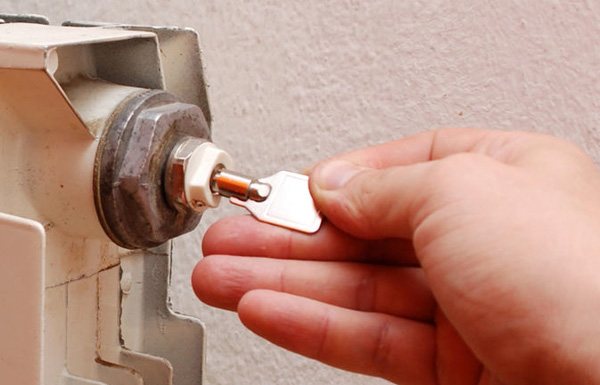

There are no Mayevsky cranes in old cast-iron batteries. The air is released without completely unscrewing the plugs at the ends of the radiators. It is better to entrust this operation to plumbers - if you unscrew the plug completely, you can flood the apartment.
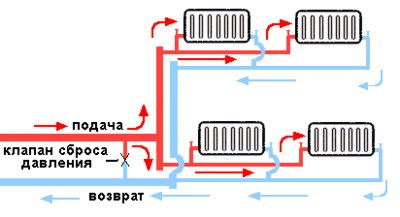

The heating system is a complex structure consisting of several elements combined into one circuit and is put into operation through a chain reaction.
But it happens that the system fails and the water in the batteries becomes cold. The reason for this may be problems with the return.
where they pass, the temperature difference between them, the pressure on the radiators
The comfort of the family in winter will depend on how effectively the heating system in the house is working.
If the batteries do not heat up well, it is necessary to eliminate the malfunction, and for this it is important to know how the heating works as a whole.
Water heating of the space is a heat source and heat carrier, which is carried through the batteries.Supply and return are present in one- and two-pipe systems. In the second, there is no clear distribution, it is conventionally accepted to divide the pipe in half.
Odnoklassniki
Features of supply in the heating system
The heat is supplied directly from the boiler, while the liquid is carried through the batteries from the main element - the boiler (or the central system). It is typical for a one-pipe system. If it is improved, then it is possible to insert pipes into the return line as well.
Photo 1. Heating scheme for a private two-story house with an indication of the supply and return pipes.
Where is the return line
In short, the heating circuit consists of several important elements: a heating boiler, batteries and an expansion tank. In order for the heat to flow through the radiators, a coolant is needed: water or antifreeze. With a competent construction of the circuit, the coolant heats up in the boiler, rises through the pipes, increasing its volume, and all the excess enters the expansion tank.
Based on the fact that the batteries are filled with liquid, hot water displaces cold water, which, in turn, enters the boiler again for subsequent
ogon.guru
Cardinal measure - replacement of heating batteries ↑
Unfortunately, old radiators, which have been regularly heating a home for decades, can no longer be brought back to life by flushing. If, even after a general internal cleaning, the batteries remain cold when the riser is heated, they will have to be mercilessly replaced with new ones. For the bathroom, radiators made of stainless steel or chrome-plated are ideal. When buying a painted radiator, you should take into account the quality of the paint application - in conditions of high humidity, it must be flawless.
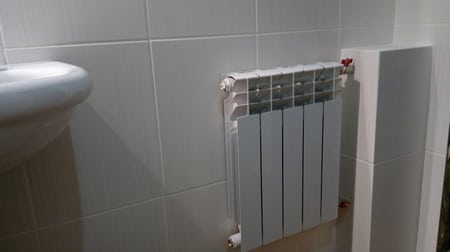

The new radiator will solve the problem of insufficient heating
Aluminum heat exchangers have a low working pressure, so they are not recommended for installation in apartments located above the 8th floor. In addition to this drawback, they have another significant disadvantage - the inner surface of these products is subject to corrosion, so you should not expect long years of service from them.
Radiators with towel racks are produced especially for bathrooms. They not only fulfill their main function, but also allow you to neatly hang towels for quick drying. To decorate the bathroom, you can choose unusual radiators, which are now easy to find.
Replacing radiators is a complex and time-consuming process that is best left to professionals. Naturally, major repairs should be planned for the season, when the heating in the house is turned off.
It is recommended to install chrome-plated surfaces away from possible splashes, otherwise they will be constantly covered with ugly stains.


